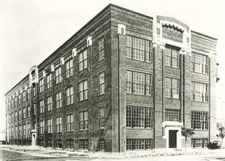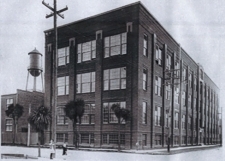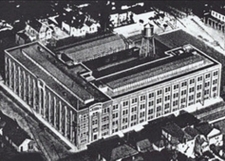|
|
|
Introduction
The Oakland Lamp Plant was built by the Oakland Warehouse Company, originally founded as a distributor of lamps. In view of the fact that most American lamps were manufactured in the industrial East and distribution to the West was hampered by poor transport links across the Rocky Mountains, demand eventually reached the point that local manufacturing was attractive. Relations were established with the National Lamp Works of General Electric to set up a factory. Oakland prospered quickly, and ultimately became sole supplier of lamps to much of the Pacific coast. Its demise was triggered in part due to its architectural limitations which prevented the installation of modern high-speed lampmaking groups, as well as the gradual improvement in transport links across America, and the factory was closed in 1961.
|

Aerial View of Oakland Mazda Works, 1920 |
| Address |
1614 Campbell Street & 1648 16th Street, West Oakland, California, U.S.A. |
| Location |
37.8134°N, -122.2934°E |
| Opened |
1912. |
| Closed |
1961. |
| Floorspace |
Approx. 140,000 sq.ft. |
| Products |
Tungsten Filament drawn-wire lamps, tungsten filament gasfilled lamps. |
Foundation by The Oakland Warehouse Company
The origins of the lamp industry in Oakland can be traced to 1903, when the Oakland Warehouse Company established an operation for the distribution of electric lamps and general illuminating equipment. Part of the reason for the decision was because the majority of American lamps at the time were being manufactured in the industrialised East, and transport connections with the Western part of the country, hindered by the obstacle of the Rocky Mountains, were less than ideal.
The company's original premises were located in downtown Oakland, on the corner of Twelfth Street and Clay Street. It operated a modest warehouse of 15,000 square feet, from which an average of about 125,000 lamps per month were distributed. It soon supplied virtually all of the major consumers of lamps along the Pacific Coast, and acted as distributor for the following lampmakers:
|
|
Banner Electric Company, Youngstown OH |
|
Brilliant Electric Company, Cleveland OH |
|
Bryan-Marsh Company, Chicago IL |
|
Buckeye Electric Company, Cleveland OH |
|
Colonial Electric Company, Warren PA |
|
Columbia Incandescent Lamp Company, St.Louis MO |
|
Fostoria Incandescent Lamp Company, Fostoria OH |
|
General Incandescent Lamp Company, Cleveland OH |
|
Monarch Incandescent Lamp Company, Chicago IL |
|
New York & Ohio Company, Warren OH |
|
Shelby Electric Company, Shelby OH |
|
Sterling Electrical Manufacturing Company, Warren OH |
|
Sunbeam Incandescent Lamp Company, Chicago IL |
|
Warren Electrical & Specialty Company, Warren OH |
The company was founded by two men, who had enjoyed a long association with the lamp manufacturing industry in the East. The General Manager was Mr J.A. Vandegrift, who relocated to the West in 1894 when he became responsible for the Pacific Coast division of his employer, the Bryan-Marsh Company. The Superintendent was Mr. R.C. Hyde, formerly associated with the Central Falls Lamp Company of Rhode Island, who made the Westward journey in 1897. After setting up the business they were joined in 1910 by their energetic young Assistant Manager, Mr. G.E. Norris, formerly of the Banner Electric Company.
|
From Distributing to Manufacturing
As demand for lamps along the Pacific Coast increased, the time inevitably arrived when the costs of investing in local manufacturing for the region could be justified. This decision appears to have been taken around 1910, when the Austin Company of Cleveland was commissioned to build a lamp factory for the Oakland Warehouse Company. Austin had enjoyed a long association with the National Lamp Works of General Electric, having built several of its factories as well as the company's prestigious Headquarters at NELA Park, Cleveland. Austin became especially skilled in the construction of industrial buildings, and achieved a particularly successful balance between functionality, sound engineering design as well as a certain touch of elegance. The architecture of the Oakland Lamp Plant is most unusual for the region - Austin's work having been confined, until then, to the East. As such the building continues to enjoy specially protected status even today.
It is not clear precisely what association existed between National and the Oakland Warehouse Company, because the original permit for the construction of the factory was issued in the name of the latter. However it cannot have been coincidence that the contractor chosen for the construction of the site was National's preferred partner. As a major distributor of lamps made by several of the Divisions of National, the two companies must have been aware that at a certain moment, the establishment of local production would be a logical development, and perhaps embarked on a joint project to set up the production.
|
Start of Lampmaking
Construction of the first part of the lamp works took place over the period 1910-1912, on a 1.43 acre tract of land on the corner of Campbell Street and Sixteenth Street. That city block was almost entirely empty at the time. The main body of the factory took the form of a four-storey construction with partial basement, measuring 62 feet wide by 231 feet long. It provided a floorspace of 65,000 square feet, and the cost of the construction was put at US$ 60,000. When the factory entered service in 1912, it became General Electric's 19th lamp manufacturing Division. Originally known as the Oakland Mazda Division, it was likely consructed specifically for the production of the company's latest tungsten lamps having drawn wire filaments.
By 1914 the production volume had risen to the level of about three million lamps per year. The territories it supplied were primarily distributed across the regions of California, Arizona, Nevada, Idaho, Oregon, Washington, Alaska and Hawaii. At that time it was one of fourteen lamp factories being operated by the National Lamp Works of GE.
In 1916, a small brick and wood frame building was added along 17th Street.
In 1917 the size of the site was approximately doubled, with a second main L-shaped structure being built along 16th Street. Its architectural style matched the original construction, and it measured 67 x 191 feet. The cost of the extension was US$ 93,000. By this time the plant was most definitely associated with National, the building permit for the extension having been issued in the name of that company.
By 1919 the operation had expanded considerably, employing 600 staff. In 1923 that figure had increased to 650, and the factory supplied almost the entire Pacific Coast requirement for incandescent lamps.
|
Closure
As lamp manufacturing methods improved during the following decades, the former production systems of manufacturing each component or stage of the assembly in a different department was phased out. Fully mechanised production lines, with each machine being responsible for the production of a lamp from start to finish began to take over, bringing a considerable reduction in the human labour content by eliminating the need to transfer sub-assemblies between different production areas.
The multi-storey building of relatively narrow width was less than ideal for the new production arrangements, and its manufacturing efficiency gradually fell behind the more advanced techniques being introduced at other factories. In parallel, new and improved transport links between the East and West of the United States gradually eliminated the requirement for factories that only supplied their own local regions. GE's high-efficiency factories in the Eastern and Central parts of the USA could make a product and transport it to the West at prices with which the Oakland facility could no longer compete.
Faced with such a scenario, closure was unavoidable and the plant's history as a lamp works came to an end in 1961. Thereafter it was occupied by California Cotton Mills, and manufactured cotton floor mops from 1962-1980. Its next operator was the Relianc Products Inc., manufacturing insulation materials for the garment industry. The structure was seriously damageed in the Loma Prieta earthquake of 1989 and lay derelict for many years, but in view of its protected status as one of Oakland's historical monuments, it was restored and brought back to service. During the period 2008-2014 it was adapted for residential use, and today the so-called 'Lampwork Lofts' houses 93 high quality apartments.
|
Photographs
|
 |
|
 |
|
 |
|
|
| Original Building, c.1910(1) |
|
First Extension, c.1914-17(1) |
|
Final Extension, c.1920(1) |
|
|
|
|
|
|
|
|